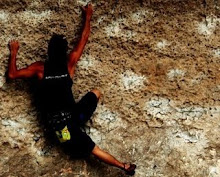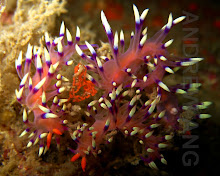
Wednesday, July 23, 2008
Nepolean Wrasse a.k.a. Humphead Wrasse

Only 3 of these Nepolean Wrasse in the whole of Redang Island have been spotted so far & we were all so fortunate to be able to see one of them this trip. Its so huge. 2 Metres in length
(6 feet) to be exact. We obviously saw the male because the female only grows to about 1 metre in length.
The humphead wrasse is the largest living member of the family Labridae. It has thick, fleshy lips and a hump that forms on its head above the eyes, becoming more prominent as the fish ages. Males range from a bright electric blue to green, a purplish blue, or a relatively dull blue/green. Juveniles and females are red-orange above, and red-orange to white below. Some males grow very large, with one unconfirmed report of a Humphead Wrasse that was 7.75 feet (2.29 m) long and weighed 420 lbs (190.5 kg).
The species is most often observed in solitary male-female pairs, or groups of two to seven individuals.
The one we saw was swimming on its own. No words can really describe the feeling that I experienced while Diving so close to this beautiful fish. I definitely have to thank our Dive Master for noticing it first & then calling us to have a look.
These Nepolean Wrasse are currently on the Endangered Species List because people hunt them for their unique huge Lips. Help create awareness to save them for those of you who are going to be Divers or are already Divers.
Seeing this fish real life up close & personal is ultimately the highlight of this entire July 2008 Diving trip to Redang Island.
-AA-
Crinoid Squat Lobster
TITAN Triggerfish

Finally I got to see these brutal looking triggerfish called the Titan. This is the fish most Divers are afraid to bump into especially reproduction season. They kinda look like Marilyn Manson with the dark thick lips =P
I saw 4 adult Titan's & 1 baby Titan in total this trip to Redang Island. The Titan's are the largest of the triggerfish species and can grow up to 75 cm in length (30 inches) OR 2 and a half feet. Yes, I saw the fully grown ones which are 2 and a half feet long & they are real fat fishes, big eyes with big sharp teeth.
The fish can be very aggressive towards divers and snorkellers. Especially during reproduction season it is very territorial and will guard its nest, which it lays in a flat sandy area, vigorously against any intruders. Due to its size and strong teeth it can inflict serious injury. Bites may also be ciguatoxic.
The Titan Triggerfish will not always bite, but can swim at snorkellers and divers escorting them out of their territory. When the males (most colourful) start swimming in your direction, the best thing to do is swim away backwards kicking your fins as a defence. Failure to do so may result in being bitten.
As much as I was afraid to see these fellas, I'm glad I have seen them real life. Colorful but at the same time brutal looking creatures.
-AA-
Bumphead Parrot Fish
Remora's or Suckerfish
Jellyfish

You really don't wanna get stung by these fellas while diving. They are all over the place sometimes. Myself & my Dive buddy including our Dive Master had to keep avoiding tones of these jellyfishes during our second dive. Argh! I wasted so much of my air just to avoid these fellas. It really is very difficult to enjoy your Dive if you are surrounded by jellyfish. You tend to pay more attention looking out for them rather than other marine life. One couple join us on our first Dive & the gurl got stung at her ear.
Our 3rd Dive at Tanjung Tokong was so much better. No jellyfish to worry about. We definitely enjoyed our Dive at this site better because the sea was calm, no jellyfish to worry about & we could appreciate everything we see. And because there are no jellyfish to worry about, we can control our breathing better & Dive much longer. Best to be fully geared up & not have any part of your skin exposed whenever there's jellyfish around.. seriously!
-AA-
Tuesday, July 22, 2008
ZERO CONTACT - THE BEST PRECAUTION!
!Do not touch or handle reef creatures. Be content with just observing them.
Shuffle your feet when walking in shallow water. This will alert creatures hiding on the seabed to retreat away so you don't step on them accidentally.
!Wear clothing to avoid getting stung or scratched. Stinging coral or jellyfish can only sting exposed areas of your body. If you bump against sharp coral, clothing will help minimize cuts and injuries.
!Look carefully where you are going. Some transparent jellyfish may be hard to see and that innocent rock or coral you bump into might be some reef creature in disguise.
!Maintain good buoyancy control at all times while skin-diving, snorkelling or diving. Wearing a life-jacket when snorkelling helps you to stay buoyant and avoid contact with anything on the seabed, corals or rocks.
-AA-
Shuffle your feet when walking in shallow water. This will alert creatures hiding on the seabed to retreat away so you don't step on them accidentally.
!Wear clothing to avoid getting stung or scratched. Stinging coral or jellyfish can only sting exposed areas of your body. If you bump against sharp coral, clothing will help minimize cuts and injuries.
!Look carefully where you are going. Some transparent jellyfish may be hard to see and that innocent rock or coral you bump into might be some reef creature in disguise.
!Maintain good buoyancy control at all times while skin-diving, snorkelling or diving. Wearing a life-jacket when snorkelling helps you to stay buoyant and avoid contact with anything on the seabed, corals or rocks.
-AA-
General Precautions
Marine creatures within the reef ecosystem have evolved different types of predatory and defensive mechanisms in order to survive such as stings, spines and venomous bites. Many of these are among the world's most venomous creatures. Animal Planet's 'Most Extreme: Venom' program included in its top 10 list the box jellyfish, stonefish, blue-ringed octopus, cone shells and sea snakes. Many of these except perhaps for the box jellyfish can be found in Redang.
Fortunately for us, these creatures are not out to attack humans. We are not their natural targets or food source and they are not naturally aggressive toward us. It is only when our presence and behaviour threatens and provokes them that we may become victims of their defenses. Most human injuries are typically a result of accidental contact with these creatures. Under normal circumstances, the natural reef is not dangerous. Most unpleasant encounters involving reef life are caused by people accidentally touching them, stepping on them or simply due to ignorant and stupid actions. We can minimize accidental contact with them by observing the general precautions shown above.
-AA-
Fortunately for us, these creatures are not out to attack humans. We are not their natural targets or food source and they are not naturally aggressive toward us. It is only when our presence and behaviour threatens and provokes them that we may become victims of their defenses. Most human injuries are typically a result of accidental contact with these creatures. Under normal circumstances, the natural reef is not dangerous. Most unpleasant encounters involving reef life are caused by people accidentally touching them, stepping on them or simply due to ignorant and stupid actions. We can minimize accidental contact with them by observing the general precautions shown above.
-AA-
DEFENCE MECHANISMS
With many reef predators and prey occupying the same reef habitat, many reef creatures would rather hide when threatened and employ deception, mimicry and camouflage to disguise themselves as a first line of defense. Some even show off bold, bright colours to announce that they are poisonous. Others will distract predators with inks, lights or ejected parts. When attempts to evade the attacker is futile, they will resort to different means to protect themselves, including using predatory mechanisms as a last line of defense.
Slow-moving creatures like urchins, sea stars and cone shells use chemicals or poisons in combination with darts, spines and needles to protect themselves.
Stonefish and scorpionfish carry lethal venom on dorsal spines, rays carry venom in their stings, while boxfish, pufferfish, soapfish and toadfish secrete skin poisons.
Jellyfish, corals, anemones and hydroids use stinging cells called nematocysts to fire a mass of minute harpoons containing venom to stun and kill their prey.
Some species of octopus have venom in their saliva. For example, the bite from the tiny blue ringed octopus can be lethal to humans.
Some innocent-looking reef fishes are equipped with self-defense mechanisms. Squirrelfish and angelfishes have spines on their gill-covers which are venomous in some species of squirrelfish. Surgeonfish have a retractable blade or scalpel at the base of the tail which it uses to slash would-be attackers.
Some sea cucumbers eject white cuiverian tubules when irritated. These contain toxins that can cause blindness when it comes into contact with the eye - so make sure you wash your hands after handling them. Others are able to cast off parts of their gut as sacrificial bait or emit sticky filaments to entangle would-be predators, including humans. These body parts are regenerated.
Barracudas, sharks, eels and triggerfishes have powerful jaws for biting while the mantis shrimp uses its deadly claws to spear or smash their victims. Electric rays and electric eels can deliver high-voltage electric shocks to stun its prey.
-AA-
Slow-moving creatures like urchins, sea stars and cone shells use chemicals or poisons in combination with darts, spines and needles to protect themselves.
Stonefish and scorpionfish carry lethal venom on dorsal spines, rays carry venom in their stings, while boxfish, pufferfish, soapfish and toadfish secrete skin poisons.
Jellyfish, corals, anemones and hydroids use stinging cells called nematocysts to fire a mass of minute harpoons containing venom to stun and kill their prey.
Some species of octopus have venom in their saliva. For example, the bite from the tiny blue ringed octopus can be lethal to humans.
Some innocent-looking reef fishes are equipped with self-defense mechanisms. Squirrelfish and angelfishes have spines on their gill-covers which are venomous in some species of squirrelfish. Surgeonfish have a retractable blade or scalpel at the base of the tail which it uses to slash would-be attackers.
Some sea cucumbers eject white cuiverian tubules when irritated. These contain toxins that can cause blindness when it comes into contact with the eye - so make sure you wash your hands after handling them. Others are able to cast off parts of their gut as sacrificial bait or emit sticky filaments to entangle would-be predators, including humans. These body parts are regenerated.
Barracudas, sharks, eels and triggerfishes have powerful jaws for biting while the mantis shrimp uses its deadly claws to spear or smash their victims. Electric rays and electric eels can deliver high-voltage electric shocks to stun its prey.
-AA-
Pink Whipray

Went to Stingray City to see some rays & managed to see these type of rays. They are called the Pink Whiprays. This is the kind of ray that stung the late Steve Erwin. If these rays are chilling at the bottom, a Diver must never swim directly above them because their tails can swing upwards & sting to defend themselves.
-AA-
Friday, July 18, 2008
Oldtown Kopitiam

I gotta tell ya people that Oldtown Kopitiam's toast breads are really good. I have these toast bread every week without fail. I pretty much know where most of the oldtown branches are now. I also go there for their white coffee. Kinda bored of Starbucks nowadays but still go there occasionally.
-AA-
Thursday, July 17, 2008
WHY SO SERIOUS?????

Watched the Premier of The Dark Knight & I must say its a darn awesome movie & The late Heath Ledger's performance definitely blew everyones minds as The Joker! He plays a better Joker then Jack Nicholson for sure. Much Darker & way way Wittier.
Loads of action, good punch lines, loads of Witt. There's no doubt that The Dark Knight is 2008's movie of the year & the late Heath Ledger deserves the Oscar for his last full film performance & not because of pity!
-AA-
Monday, July 14, 2008
Mua ALL BLACK Apollo Mask & Gull Snorkel
Wednesday, July 2, 2008
The Art Of Balancing
Subscribe to:
Comments (Atom)

























































